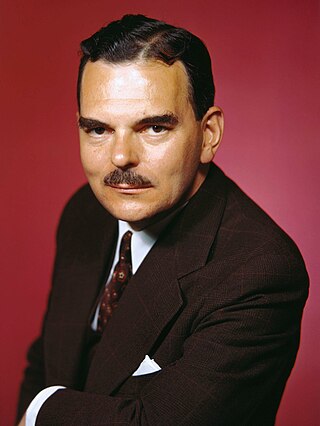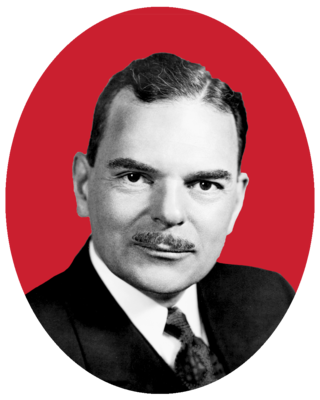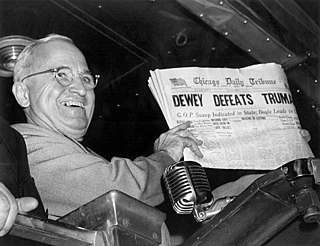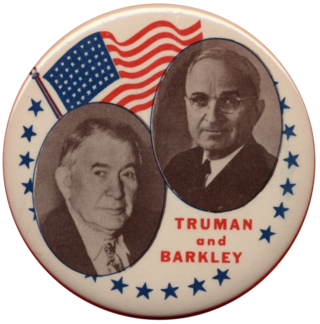
The 1944 United States presidential election was the 40th quadrennial presidential election. It was held on Tuesday, November 7, 1944. The election took place during World War II, which ended the following year. Incumbent Democratic President Franklin D. Roosevelt defeated Republican Thomas E. Dewey to win an unprecedented fourth term. It was also the fifth presidential election in which both major party candidates were registered in the same home state; the others have been in 1860, 1904, 1920, 1940, and 2016.

The 1948 United States presidential election was the 41st quadrennial presidential election. It was held on Tuesday, November 2, 1948. In one of the greatest election upsets in American history, incumbent President Harry S. Truman, the Democratic nominee, defeated heavily-favored Republican Governor of New York Thomas E. Dewey, and third-party candidates, becoming the third president to succeed to the presidency upon his predecessor’s death and be elected to a full term.

The 1952 United States presidential election was the 42nd quadrennial presidential election and was held on Tuesday, November 4, 1952. Republican Dwight D. Eisenhower won a landslide victory over Democrat Adlai Stevenson II, becoming the first Republican president in 20 years.

Thomas Edmund Dewey was an American lawyer and politician who served as the 47th governor of New York from 1943 to 1954. He was the Republican Party's nominee for president of the United States in 1944 and in 1948, where he lost in a major upset to Harry Truman. The 288 combined electoral votes Dewey received from both elections place him second behind William Jennings Bryan as the candidate with the most electoral votes who never acceded to the presidency.

Robert Alphonso Taft Sr. was an American politician, lawyer, and scion of the Republican Party's Taft family. Taft represented Ohio in the United States Senate, briefly served as Senate Majority Leader, and was a leader of the conservative coalition of Republicans and conservative Democrats who blocked expansion of the New Deal. Often referred to as "Mr. Republican", he co-sponsored the Taft–Hartley Act of 1947, which banned closed shops, created the concept of right-to-work states, and regulated other labor practices.
The 1948 Democratic National Convention was held at Philadelphia Convention Hall in Philadelphia, Pennsylvania, from July 12 to July 15, 1948, and resulted in the nominations of President Harry S. Truman for a full term and Senator Alben W. Barkley of Kentucky for vice president in the 1948 presidential election. One of the decisive factors in convening both major party conventions in Philadelphia that year was that the eastern Pennsylvania area was part of the newly developing broadcast television market. In 1947, TV stations in New York City, Washington and Philadelphia were connected by a coaxial cable. By the summer of 1948 two of the three new television networks, NBC and CBS, had the ability to telecast along the east coast live gavel-to-gavel coverage of both conventions. In television's early days, live broadcasts were not routinely recorded, but a few minutes of Kinescope film of the conventions has survived.

The 1952 Republican National Convention was held at the International Amphitheatre in Chicago, Illinois from July 7 to 11, 1952, and nominated the popular general and war hero Dwight D. Eisenhower of New York, nicknamed "Ike", for president and the anti-communist crusading Senator from California, Richard M. Nixon, for vice president.

The 80th United States Congress was a meeting of the legislative branch of the United States federal government, composed of the United States Senate and the United States House of Representatives. It met in Washington, D.C. from January 3, 1947, to January 3, 1949, during the third and fourth years of Harry S. Truman's presidency. The apportionment of seats in this House of Representatives was based on the 1940 United States census.

The 1948 Republican National Convention was held at the Municipal Auditorium, in Philadelphia, Pennsylvania, from June 21 to 25, 1948.

"Dewey Defeats Truman" was an incorrect banner headline on the front page of the Chicago Daily Tribune on November 3, 1948, the day after incumbent United States president Harry S. Truman won an upset victory over his opponent, Governor Thomas E. Dewey of New York, in the 1948 presidential election. It was famously held up by Truman at a stop at St. Louis Union Station following his successful election, smiling triumphantly at the error.

Harry S. Truman was the 33rd president of the United States, serving from 1945 to 1953. A member of the Democratic Party, he previously served as the 34th vice president from January to April 1945 under Franklin D. Roosevelt and as a United States senator from Missouri from 1935 to January 1945. Assuming the presidency after Roosevelt's death, Truman implemented the Marshall Plan to rebuild the economy of Western Europe and established both the Truman Doctrine and NATO to contain the expansion of Soviet communism. He proposed numerous liberal domestic reforms, but few were enacted by the conservative coalition that dominated the Congress.
The 1940 Republican National Convention was held in Philadelphia, Pennsylvania, from June 24 to June 28, 1940. It nominated Wendell Willkie of New York for president and Senator Charles McNary of Oregon for vice president.

Harry S. Truman's tenure as the 33rd president of the United States began on April 12, 1945, upon the death of Franklin D. Roosevelt, and ended on January 20, 1953. He had been vice president for only 82 days. A Democrat from Missouri, he ran for and won a full four–year term in the 1948 election. Although exempted from the newly ratified Twenty-second Amendment, Truman did not run again in the 1952 election because of his low popularity. He was succeeded by Republican Dwight D. Eisenhower in 1953.

From March 9 to June 1, 1948, voters of the Republican Party elected delegates to the 1948 Republican National Convention, in part to choose the party nominee for president in the 1948 United States presidential election.

From March 12 to May 17, 1940, voters of the Republican Party chose delegates to nominate a candidate for president at the 1940 Republican National Convention. The nominee was selected at the convention in Philadelphia, Pennsylvania from June 24–28, 1940.

The 1948 United States elections were held on November 2, 1948. The election took place during the beginning stages of the Cold War. Democratic incumbent President Harry S. Truman was elected to a full term in an upset, defeating Republican nominee New York Governor Thomas E. Dewey and two erstwhile Democrats. The Democrats won back control of Congress from the Republicans. Until 2020, Democrats would never again flip a chamber of Congress in a presidential election cycle.

Electoral history of Robert A. Taft, United States Senator from Ohio (1939–1953), United States Senate Majority Leader (1953) and a candidate for the 1940, 1948 and 1952 Republican presidential nominations.

The 1948 United States presidential election in Florida was held on November 2, 1948. Voters chose eight electors, or representatives to the Electoral College, who voted for president and vice president.

The 1948 United States presidential election in Wyoming took place on November 2, 1948, as part of the 1948 United States presidential election. State voters chose three representatives, or electors, to the Electoral College, who voted for president and vice president. Wyoming was won by incumbent Democratic President Harry S. Truman, running with Senate Majority Leader Alben W. Barkley, with 51.62 percent of the popular vote, against the Republican nominee, 47th Governor of New York Thomas E. Dewey, running with California Governor and future Chief Justice of the United States Earl Warren, with 47.27 percent of the popular vote, despite the fact that Dewey had previously won the state four years earlier.

In 1948, Harry S. Truman and Alben W. Barkley were elected president and vice president of the United States, defeating Republican nominees Thomas E. Dewey and Earl Warren. Truman, a Democrat and vice president under Franklin D. Roosevelt, had ascended to the presidency upon Roosevelt's death in 1945. He announced his candidacy for election on March 8, 1948. Unchallenged by any major nominee in the Democratic primaries, he won almost all of them easily; however, many Democrats like James Roosevelt opposed his candidacy and urged former Chief of Staff of the United States Army Dwight D. Eisenhower to run instead.
















